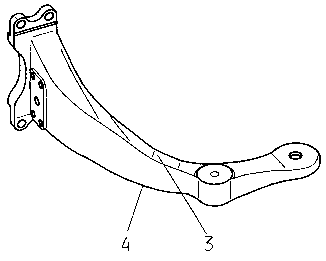Une partie des informations de ce site Web a été fournie par des sources externes. Le gouvernement du Canada n'assume aucune responsabilité concernant la précision, l'actualité ou la fiabilité des informations fournies par les sources externes. Les utilisateurs qui désirent employer cette information devraient consulter directement la source des informations. Le contenu fourni par les sources externes n'est pas assujetti aux exigences sur les langues officielles, la protection des renseignements personnels et l'accessibilité.
L'apparition de différences dans le texte et l'image des Revendications et de l'Abrégé dépend du moment auquel le document est publié. Les textes des Revendications et de l'Abrégé sont affichés :
| (12) Demande de brevet: | (11) CA 2409322 |
|---|---|
| (54) Titre français: | PONT PORTIQUE |
| (54) Titre anglais: | OFFSET AXLE |
| Statut: | Réputée abandonnée et au-delà du délai pour le rétablissement - en attente de la réponse à l’avis de communication rejetée |
| (51) Classification internationale des brevets (CIB): |
|
|---|---|
| (72) Inventeurs : |
|
| (73) Titulaires : |
|
| (71) Demandeurs : |
|
| (74) Agent: | NORTON ROSE FULBRIGHT CANADA LLP/S.E.N.C.R.L., S.R.L. |
| (74) Co-agent: | |
| (45) Délivré: | |
| (86) Date de dépôt PCT: | 2001-06-02 |
| (87) Mise à la disponibilité du public: | 2002-11-15 |
| Licence disponible: | S.O. |
| Cédé au domaine public: | S.O. |
| (25) Langue des documents déposés: | Anglais |
| Traité de coopération en matière de brevets (PCT): | Oui |
|---|---|
| (86) Numéro de la demande PCT: | PCT/EP2001/006315 |
| (87) Numéro de publication internationale PCT: | EP2001006315 |
| (85) Entrée nationale: | 2002-11-15 |
| (30) Données de priorité de la demande: | ||||||
|---|---|---|---|---|---|---|
|
Le pont portique d'autocars présente, d'une part, un carter qui abrite un différentiel, lequel est relié à deux arbres d'essieu et, d'autre part, une suspension permettant de relier le carter au véhicule et présentant des supports de ressorts constitués d'une ou de deux pièce(s). Les supports de ressorts sont des pièces moulées pleines sans noyau. Dans la zone de courbure entre l'élément ressort et le carter, la résistance mécanique peut bénéficier de bosses rehaussées.
The offset axle for buses has a housing in which a differential is located,
said differential being connected to two axle shafts; and a suspension for
connecting the housing to the vehicle. Said suspension has single or multiple
part spring carriers which consist of corelessly, completely cast metal. Humps
can be provided in the area of the curvature between the spring element and
the housing in order to increase strength.
Note : Les revendications sont présentées dans la langue officielle dans laquelle elles ont été soumises.
Note : Les descriptions sont présentées dans la langue officielle dans laquelle elles ont été soumises.

2024-08-01 : Dans le cadre de la transition vers les Brevets de nouvelle génération (BNG), la base de données sur les brevets canadiens (BDBC) contient désormais un Historique d'événement plus détaillé, qui reproduit le Journal des événements de notre nouvelle solution interne.
Veuillez noter que les événements débutant par « Inactive : » se réfèrent à des événements qui ne sont plus utilisés dans notre nouvelle solution interne.
Pour une meilleure compréhension de l'état de la demande ou brevet qui figure sur cette page, la rubrique Mise en garde , et les descriptions de Brevet , Historique d'événement , Taxes périodiques et Historique des paiements devraient être consultées.
| Description | Date |
|---|---|
| Demande non rétablie avant l'échéance | 2006-06-02 |
| Le délai pour l'annulation est expiré | 2006-06-02 |
| Réputée abandonnée - omission de répondre à un avis sur les taxes pour le maintien en état | 2005-06-02 |
| Lettre envoyée | 2003-07-28 |
| Inactive : Transfert individuel | 2003-06-06 |
| Inactive : Lettre de courtoisie - Preuve | 2003-02-18 |
| Inactive : Page couverture publiée | 2003-02-13 |
| Inactive : Notice - Entrée phase nat. - Pas de RE | 2003-02-11 |
| Demande reçue - PCT | 2002-12-10 |
| Exigences pour l'entrée dans la phase nationale - jugée conforme | 2002-11-15 |
| Demande publiée (accessible au public) | 2002-11-15 |
| Exigences pour l'entrée dans la phase nationale - jugée conforme | 2002-11-15 |
| Date d'abandonnement | Raison | Date de rétablissement |
|---|---|---|
| 2005-06-02 |
Le dernier paiement a été reçu le 2004-05-20
Avis : Si le paiement en totalité n'a pas été reçu au plus tard à la date indiquée, une taxe supplémentaire peut être imposée, soit une des taxes suivantes :
Les taxes sur les brevets sont ajustées au 1er janvier de chaque année. Les montants ci-dessus sont les montants actuels s'ils sont reçus au plus tard le 31 décembre de l'année en cours.
Veuillez vous référer à la page web des
taxes sur les brevets
de l'OPIC pour voir tous les montants actuels des taxes.
| Type de taxes | Anniversaire | Échéance | Date payée |
|---|---|---|---|
| Taxe nationale de base - générale | 2002-11-15 | ||
| TM (demande, 2e anniv.) - générale | 02 | 2003-06-02 | 2002-11-15 |
| Enregistrement d'un document | 2003-06-06 | ||
| TM (demande, 3e anniv.) - générale | 03 | 2004-06-02 | 2004-05-20 |
Les titulaires actuels et antérieures au dossier sont affichés en ordre alphabétique.
| Titulaires actuels au dossier |
|---|
| ZF FRIEDRICHSHAFEN AG |
| Titulaires antérieures au dossier |
|---|
| ALFRED JUNK |
| PAUL LENZ |